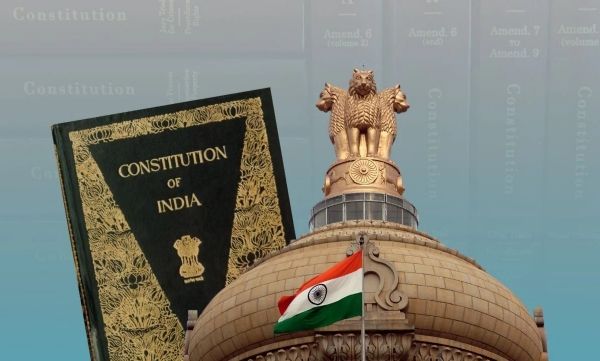Author : Nilakshi Suryawanshi, a student at Dr. Babasaheb Ambedkar Memorial College of Law, Dhule.
ABSTRACT
The Indian Independence Movement, a cornerstone of India’s national history, was not only a political revolution but also a movement to establish a framework grounded in justice, equality, and human rights. This article examines how the movement’s legal ideologies and reforms laid the foundation for the Indian Constitution, detailing key provisions, legal doctrines, and landmark judgments that embody the movement’s principles. The Constitution stands as a living document, enshrining the ideals of sovereignty, democracy, and justice that emerged during India’s freedom struggle, shaping the modern legal and political landscape.
INTRODUCTION
The Indian Independence Movement, spanning over a century, was a monumental struggle against British colonial rule, driven by the principles of self-determination, justice, and equal rights. At its core, the movement sought not only political autonomy but also the creation of a legal system that upheld the rule of law and protected civil liberties. The Indian Constitution, drafted in the aftermath of independence, reflects these aspirations and ensures that the foundational values of the independence era permeate the country’s legal framework. This article delves into the profound impact of the independence movement on the Indian Constitution, particularly its influence on fundamental rights, democratic governance, and federalism.
THE LEGAL LEGACY OF THE INDEPENDENCE MOVEMENT
The Indian Independence Movement was instrumental in advocating several legal principles and reforms that became the bedrock of the Indian Constitution. These legacies include :
(1) PRINCIPLES OF JUSTICE AND EQUALITY :
Central to the movement was the demand for justice and equality, a direct response to the discriminatory colonial laws that marginalized large sections of Indian society. The framers of the Constitution incorporated these ideals into its structure by providing for equality before the law (Article 14) and prohibiting discrimination on grounds of religion, race, caste, sex, or place of birth (Article 15). The fundamental rights enshrined in Part III of the Constitution were inspired by the movement’s emphasis on creating a just society, guaranteeing protections against exploitation and arbitrary state actions.
(2) DEMOCRATIC IDEALS :
The Independence Movement, particularly under leaders like Mahatma Gandhi and Jawaharlal Nehru, strongly advocated for self-rule and democratic governance. This legacy was institutionalized in the Constitution through the adoption of a parliamentary system based on democratic principles. The incorporation of universal adult suffrage ensured that governance was representative and accountable, reflecting the movement’s call for a government of the people.
(3) Human Rights and Civil Liberties :
A significant aspect of the independence struggle was the fight for civil liberties and human dignity. The Constitution guarantees a range of fundamental rights, such as the right to life and personal liberty (Article 21), freedom of speech and expression (Article 19), and protection against arbitrary detention (Articles 22-23). These provisions echo the movement’s demand for freedom from oppression and the protection of individual rights.
(4) FEDERALISM AND REGIONAL AUTONOMY :
One of the prominent demands during the independence era was for regional autonomy and decentralization of power. The Constitution adopted a federal structure that balances the distribution of powers between the Union and the States (Article 246 and the Seventh Schedule). This system allowed for both regional governance and national unity, accommodating the diverse linguistic and cultural groups within India.
KEY LEGAL PROVISIONS AND THEIR INSPIRATION
Several constitutional provisions draw directly from the ideologies of the Indian Independence Movement :
(1) PREAMBLE :
The Preamble of the Indian Constitution encapsulates the core ideals of the independence movement: sovereignty, socialism, secularism, and democracy. It emphasizes justice—social, economic, and political—along with liberty, equality, and fraternity. These principles formed the bedrock of the movement’s vision for a new India and continue to guide the nation’s democratic ethos.
(2) FUNDAMENTAL RIGHTS (PART III) :
The independence movement placed a significant focus on civil rights, which were translated into the Fundamental Rights section of the Constitution. Articles 14 to 32 guarantee rights such as equality before the law, freedom of speech, and protection from exploitation. These rights were seen as essential to building a democratic and just society.
(3) DIRECTIVE PRINCIPLES OF STATE POLICY (PART IV) :
The Directive Principles, though non-justiciable, outline the state’s responsibility in promoting social welfare, economic justice, and equitable distribution of resources. These principles reflect the goals of the independence movement to eliminate poverty, reduce inequality, and promote a welfare state, ensuring that the state is committed to fostering conditions for human dignity and economic development.
(4) FEDERAL STRUCTURE :
Reflecting the independence movement’s desire for regional autonomy, the Constitution’s federal design allows for a clear division of powers between the central and state governments. This distribution safeguards the interests of regional and linguistic diversity while ensuring a strong national government. The independence movement’s legacy of cooperative federalism continues to guide India’s political structure.
LANDMARK JUDGMENTS REFLECTING THE LEGACY
Several landmark judgments have reinforced the principles derived from the independence movement, ensuring that the Constitution remains aligned with its foundational values :
(1) KESAVANANDA BHARATI V. STATE OF KERALA (1973) :
The Supreme Court’s ruling in this case established the basic structure doctrine, which asserts that certain fundamental elements of the Constitution, such as democracy, rule of law, and separation of powers, cannot be altered by constitutional amendments. This doctrine is a direct legacy of the independence movement’s insistence on safeguarding democracy and fundamental rights.
(2) INDIRA NEHRU GANDHI V. RAJ NARAIN (1975) :
This judgment, delivered during a time of political turmoil, reaffirmed the importance of democratic processes and the accountability of elected officials. The court’s decision was rooted in the constitutional values of democratic governance and the rule of law, both key legacies of the independence movement.
(3) MINERVA MILLS LTD. V. UNION OF INDIA (1980) :
The Supreme Court in this case struck a balance between the Fundamental Rights and the Directive Principles of State Policy, emphasizing that neither could override the other. The judgment reinforced the constitutional vision of achieving both individual freedom and social justice, goals central to the independence movement.
CONCLUSION
The Indian Independence Movement was not only a fight for political freedom but also a struggle to establish a legal and democratic order based on justice, equality, and human dignity. The Indian Constitution is a living embodiment of these ideals, ensuring that the values of the movement continue to guide the nation. Through its provisions, principles, and judicial interpretations, the Constitution preserves the legal legacy of the independence movement, making it a timeless framework for governance in India.
FREQUENTLY ASKED QUESTIONS (FAQ)
Q1 : HOW DID THE INDIAN INDEPENDENCE MOVEMENT INFLUENCE THE INDIAN CONSTITUTION?
A : The movement’s emphasis on justice, equality, and democratic governance profoundly influenced constitutional provisions like the Preamble, Fundamental Rights, and Directive Principles of State Policy.
Q2 : WHAT ARE SOME KEY LEGAL PROVISIONS INSPIRED BY THE INDEPENDENCE MOVEMENT?
A : Key provisions include the Preamble, Fundamental Rights such as equality and freedom, and the federal structure that balances power between the Union and States.
Q3 : WHICH LANDMARK CASES REFLECT THE LEGAL LEGACY OF THE INDEPENDENCE MOVEMENT?
A : Notable cases include Kesavananda Bharati v. State of Kerala, Indira Nehru Gandhi v. Raj Narain, and Minerva Mills Ltd. V. Union of India.
Q4 : WHAT IS THE BASIC STRUCTURE DOCTRINE?
A : The basic structure doctrine, established in Kesavananda Bharati v. State of Kerala, holds that certain fundamental principles of the Constitution, such as democracy and the rule of law, cannot be altered by amendments.
Q5 : HOW DO THE DIRECTIVE PRINCIPLES OF STATE POLICY RELATE TO THE INDEPENDENCE MOVEMENT?
A : The Directive Principles reflect the movement’s goals of social and economic justice and guide the state in formulating policies aimed at achieving these objectives, even though they are not enforceable by law.





